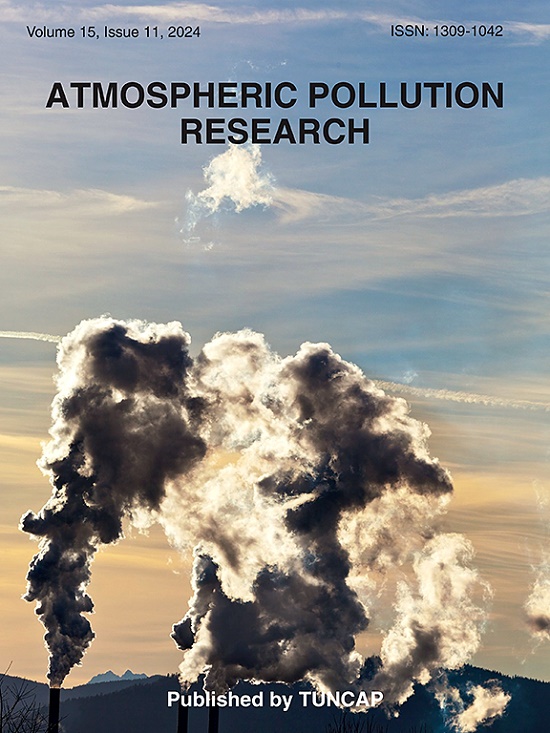室内植物诱导相对湿度对城市室内环境PM浓度的影响
IF 3.9
3区 环境科学与生态学
Q2 ENVIRONMENTAL SCIENCES
引用次数: 0
摘要
该研究调查了室内植物对相对湿度(RH)的影响,以及随后在德里CSIR- NPL自然通风的办公室中颗粒物(PM)的减少。比较了对照(不种植)和实验(种植8株金葵盆栽)两种条件下的PM浓度。比较了两种不同的情况:背景PM和熏香诱发PM。植物的存在使平均相对湿度上升13.55%,温度下降4.1%。植物诱导的RH升高导致PM I/O比降低6倍。RH值(60%)与超细、细、粗颗粒呈负相关。植物诱导的RH使所有大小颗粒的沉积损失率加快了~ 44%,并使入渗率降低了~ 78%。在排放前,除了PM干沉降外,植物诱导的RH还使细颗粒物和粗颗粒物分别大幅减少6.53%和26.45%。焚香过程中,在植物存在的情况下,超细PM浓度下降了23.41%,细PM下降了72.39%,粗PM下降了71.49%。这表明,PM的化学成分显著影响PM的还原,因为它改变了颗粒的吸湿性。Na、Mg、Al、Si、Cl和K等元素的质量百分比分别下降了1.87、1.23、2.26、5.48、0.66和0.91%。可以推断,要实现平均相对湿度增加13%,需要叶子面积相当于房间表面约6%的植物。本文章由计算机程序翻译,如有差异,请以英文原文为准。

Impact of indoor plant-induced relative humidity on PM concentration in indoor urban environment
The study investigates the influence of indoor plants on relative humidity (RH) and the subsequent reduction in particulate matter (PM) in a naturally ventilated office room at CSIR- NPL, Delhi. PM concentrations were compared under two conditions: control (without plants) and experimental (with eight potted Epipremnum aureum plants). The comparison was conducted under two distinct cases: background PM, and induced PM from incense burning.
The presence of plants resulted in an average RH increase of 13.55% and a temperature decrease of 4.1%. Plant-induced RH elevation led to a sixfold reduction in PM I/O ratios. RH values (>60%) were negatively correlated with ultrafine, fine, and coarse particles. Plant-induced RH accelerates the deposition loss rate of all sized particles by ∼44% and reduces the infiltration rate by ∼78%. During pre-emission, in addition to PM dry deposition, plant-induced RH contributed to a substantial reduction of fine PM by 6.53% and coarse PM by 26.45% respectively. During incense burning, in the presence of plants, ultrafine PM concentrations dropped by 23.41%, fine PM by 72.39%, and coarse PM by 71.49%. It demonstrates that PM chemical composition significantly influences PM reduction, as it alters particle hygroscopicity. There was a decrease in the mass percentage of elements like Na, Mg, Al, Si, Cl, and K by 1.87, 1.23, 2.26, 5.48, 0.66, and 0.91 percent respectively. It can be inferred that to achieve a 13% increase in the average RH, plants with a leaf area size equivalent to ∼6% of the room surface would be required.
求助全文
通过发布文献求助,成功后即可免费获取论文全文。
去求助
来源期刊

Atmospheric Pollution Research
ENVIRONMENTAL SCIENCES-
CiteScore
8.30
自引率
6.70%
发文量
256
审稿时长
36 days
期刊介绍:
Atmospheric Pollution Research (APR) is an international journal designed for the publication of articles on air pollution. Papers should present novel experimental results, theory and modeling of air pollution on local, regional, or global scales. Areas covered are research on inorganic, organic, and persistent organic air pollutants, air quality monitoring, air quality management, atmospheric dispersion and transport, air-surface (soil, water, and vegetation) exchange of pollutants, dry and wet deposition, indoor air quality, exposure assessment, health effects, satellite measurements, natural emissions, atmospheric chemistry, greenhouse gases, and effects on climate change.
 求助内容:
求助内容: 应助结果提醒方式:
应助结果提醒方式:


